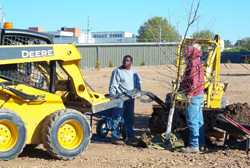Trail of Tears Park Takes Shape
The Trail of Tears Park in the southeast corner of UALR’s campus is taking shape as workers install native trees – some as tall as 30 feet – on a site that was until recently a collection of asphalt parking lots and concrete block store fronts.
The $650,000 donor-financed park project will restore the approximately 4.5 acre site to its natural state with native trees, rocks, and grasses. The area east of University Plaza was once a site where members of the Chickasaw and Choctaw nations stopped for water at the creek during the forced migration known as the Trail of Tears.
 The list of private donors to this project is lengthy and includes FTN Associates, Audubon Arkansas, The Riggs Family, Design Consultants Inc., and many others.
The list of private donors to this project is lengthy and includes FTN Associates, Audubon Arkansas, The Riggs Family, Design Consultants Inc., and many others.
Johnnie Chamberlin, representing his family’s foundation that contributed $30,000 for the purchase of the trees and $10,000 for erosion control plantings, watched as bulldozers and other pieces of heavy equipment jostled the giant root balls into place.
“Landscape engineers tell us this will be the biggest project of de-urbanization in the history of the state,” said Dave Millay, director of UALR’s Physical Plant and chair of the Coleman Creek Greenway Project. Initial work on the park began with removal of concrete pilings, asphalt, and other 20th century urban construction. Fresh soil was trucked in and groomed and hills and slopes contoured.
The Coleman Creek project, described in UALR’s Master Plan, On the Move, calls for the creation of a 47-acre greenway reaching the full length of campus with lush vegetation, bicycle and walking trails, benches, and bridges.
The restoration project will provide an outdoor laboratory for biologists, earth scientists, and hydrologists for teaching and research activities and will unite the campus and tie Coleman Creek to a regional open space system that includes the Fourche Creek Wetlands and War Memorial Park.
Creating the Coleman Creek Greenway is also a highlight of a strategic plan for the University District, the business corridors and neighborhoods surrounding the UALR campus. The University District Partnership is working to redevelop areas around the campus to create a dynamic urban place and improve the quality of life for all persons who live, work, learn, shop, and play in the area.